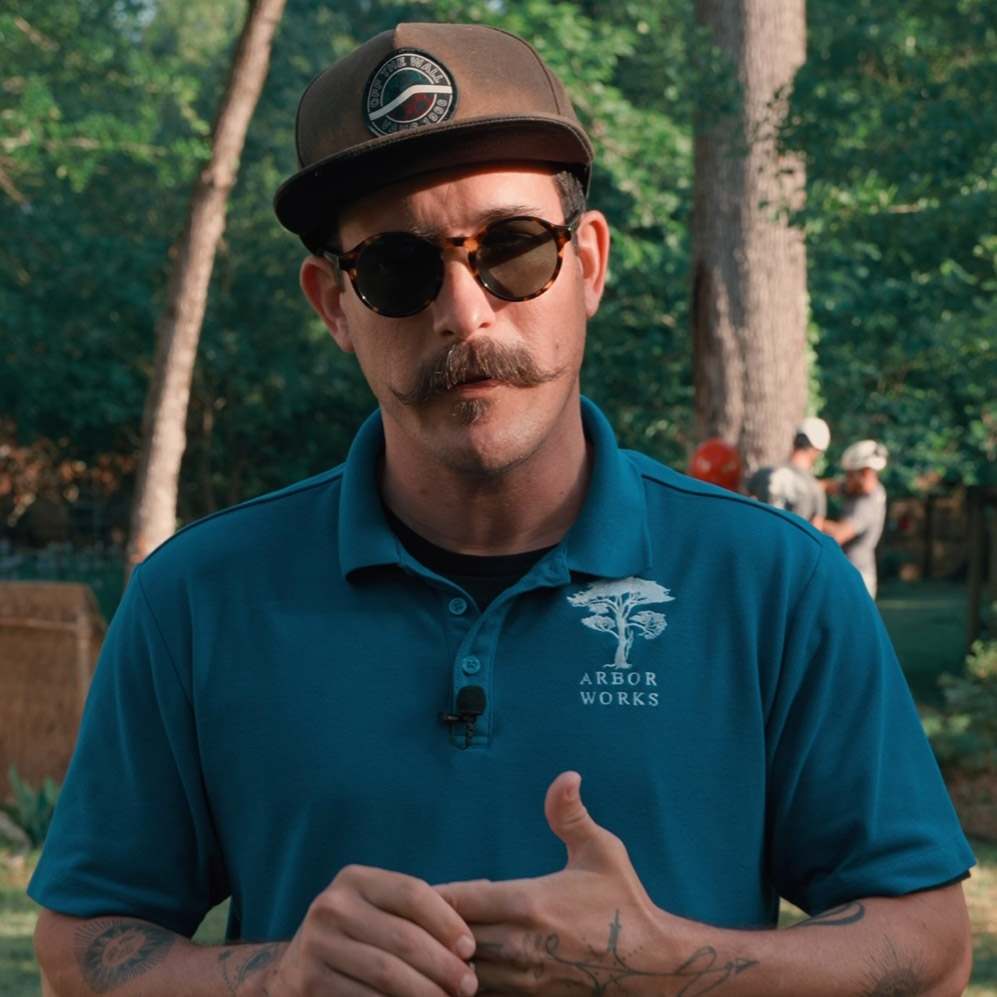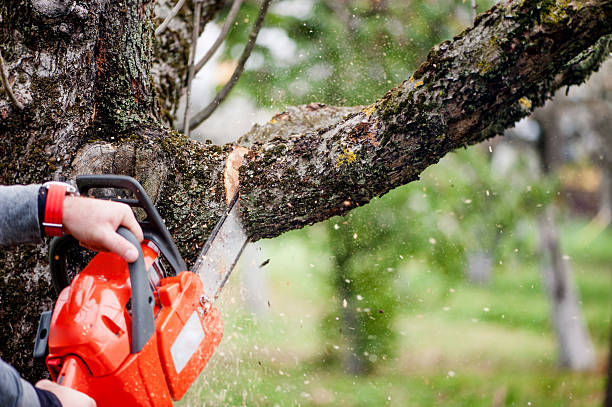Cutting down a tree might look simple at a glance, but up close it’s far more involved than grabbing a chainsaw and taking a swing at the trunk. Every tree reacts differently once cuts begin, and small mistakes can lead to injuries, property damage, or a tree falling in the wrong direction. ArborWorks explains how to cut down a tree in plain language so property owners understand the process before attempting anything. This helps people see why trained pros are the safer choice for cutting down trees, handling storm-damaged limbs, and removing risky oaks, pines, and hardwoods in tight spaces.
We speak with clients every day who ask about chopping down trees themselves. Some think a sharp chainsaw is enough. Others feel confident because they’ve cut small limbs before. Yet the truth is, full tree removal carries far more danger than it appears. That’s why this guide walks step-by-step through what goes into how to cut down a tree, how ArborWorks approaches safety, and why hiring certified specialists reduces stress and saves money in the long run.
Understanding How to Cut Down a Tree Before Starting
Before anyone begins chopping down a tree with a chainsaw, the most important part of the job happens before the first cut. A certified arborist looks at the full picture so the removal doesn’t go sideways.
Here’s what ArborWorks checks during an evaluation:
- Tree condition
A tree that’s rotting inside, leaning, or cracked reacts differently once cuts begin. Our team checks the trunk, branches, crown, and root zone. Weak wood can split unexpectedly, which creates sudden movement that even experienced people struggle to handle.
- Surroundings
Nearby houses, fences, sheds, powerlines, and driveways all affect the plan. Trees don’t always fall the way property owners expect, which is why ArborWorks maps out escape routes and fall zones well in advance.
- Safety factors
The level of decay, wind direction, soil condition, and nearby traffic all change the approach. Before cutting down trees, we set the area so nothing catches people off guard.
For clients dealing with sick or declining trees, ArborWorks often recommends a Tree Health Inspection.
How to Cut Down a Tree: Step-By-Step Arborist Method
Below is a clear breakdown of how to cut down a tree in a controlled and predictable way. This isn’t meant to be a DIY starter kit. Instead, it shows what a safe removal actually involves so you can make informed choices.
1. Clear the Drop Zone
The drop zone is the area where the tree is expected to fall. ArborWorks always clears loose debris, equipment, and anything a falling trunk might strike. Since trees don’t fall perfectly, the zone must be wider than most people guess.
2. Plan Multiple Escape Paths
A chainsaw can kick, a trunk can twist, and branches can break. Because of all this movement, our arborists set up more than one exit path. These routes angle away from the tree at about 45 degrees so the crew can move fast if something shifts.
3. Make the Face Cut
The face cut is the first major cut in the removal. It controls the direction of the fall.
We usually create:
-
A top cut
This cut starts at an angle and goes downward into the trunk. It forms the top part of the notch. The angle matters because it dictates how the trunk begins to lean.
-
A bottom cut
This cut meets the top cut to complete the notch. When done correctly, it guides the tree in the planned direction instead of letting gravity choose the path. Both cuts must be clean, even, and shaped correctly. A sloppy notch makes the tree unpredictable.
4. Begin the Back Cut
The back cut is what releases the tree from the stump. It lands above the notch and creates a hinge of wood that helps control the fall. ArborWorks measures the hinge carefully so the trunk doesn’t snap too early or too late. Every inch of hinge thickness matters.
5. Retreat to Safety as the Tree Falls
Once the hinge begins to lift and the tree starts to fall, the team follows the escape route. No one stands behind the tree. No one moves under the falling trunk. We let gravity finish the job while every crew member stays alert.
People often ask, “Can someone who’s never done this safely handle chopping down a tree with a chainsaw?” After seeing what goes into each step, most realize the risks are higher than expected.
For full tree removal assistance, ArborWorks provides safe, insured, and certified service.
How to Cut Down a Tree Without Damaging Property
Homeowners are often surprised at how a large tree reacts once cuts begin. The trunk can twist, branches can shift, and weight can redistribute in seconds. ArborWorks uses ropes, wedges, helmets, chaps, and stabilizing equipment to manage the tree as it moves.
Here’s how ArborWorks reduces the chance of damage:
- Directional felling techniques help guide the tree toward a safe landing zone.
- Rope rigging allows our crew to lower heavy limbs instead of letting them drop.
- Spotters watch for movement and warn the cutter of sudden shifts.
- Storm Prep & Risk Mitigation services help weaken or leaning trees fall safely during major weather.
Learning how to cut down a tree safely involves far more planning than most DIY guides mention. Even small miscalculations can send a trunk toward a roof, vehicle, or neighbor’s yard. That’s why ArborWorks often recommends professional service before anyone attempts this alone.
Why Hiring ArborWorks Is Safer Than DIY Tree Cutting
Many property owners feel confident until the tree starts leaning in a direction they didn’t expect. Tree work is loud, fast, and heavy. Once the trunk begins to move, there’s no stopping it.
Here’s why ArborWorks is the safer choice:
Training and Certification
ArborWorks follows ISA standards for tree removal and safety. This helps control the fall even during tough removals.
Professional Equipment
Our crew uses climbing gear, wedges, rigging ropes, and saws designed for large trees. This equipment helps manage the weight and movement.
Liability Protection
If anything goes wrong during DIY tree removal, you’re responsible. ArborWorks protects you by handling the job with proper insurance and skilled specialists.
Full-Service Care
Sometimes a tree doesn’t need removal. It might only need trimming or a health check.
You can look into those services here:
Contact ArborWorks for Safe Tree Removal in Louisiana
If you’re looking for help cutting down trees, dealing with a hazardous oak, or planning a safe removal before storm season, ArborWorks is ready. Call our certified arborist team at (985) 951-0128 or reach out through our contact page.
We’ll inspect the tree, create a removal plan, and handle the entire project with care and precision so you don’t have to risk a dangerous job.
FAQs About How to Cut Down a Tree
Is it safe to cut down a tree on my own?
It depends on the size, condition, and location of the tree. Small trees with clear space might be manageable, but anything leaning, tall, close to powerlines, or showing decay should be handled by trained pros.
Do I need special gear?
Yes. Tree removal requires protective equipment, ropes, wedges, chaps, proper helmets, and a reliable chainsaw. Most homeowners don’t own the right gear for safe removal.
What happens if a tree starts falling in the wrong direction?
There’s no easy fix. Once the trunk moves, it carries huge force. That’s why ArborWorks plans the cuts, fall path, and escape routes in advance.
How much does professional tree removal cost?
The price changes based on height, width, location, and condition. ArborWorks offers site evaluations so you know what to expect.




